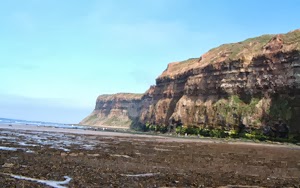You
have been asked to photograph the Cliffs of Whitby or Saltburn from the bottom and the top for
a travel guide.
Risk(s): Taking photos in an environment where there are cliffs means that there is a risk of rocks or branches etc falling from above. These rocks falling could hit your head and lead to serious injuries. Being on top of the cliff would present the hazard of falling from
a large height and the consequences could potentially be fatal. It may be the case that you do not fall over the edge of the cliff but your camera does, this would result in the expensive equipment smashing and breaking. This may occur by tripping over stray rocks and uneven ground, when being too focused on using the camera. As well as this, these locations are usually very cold and in the open so this could lead to freezing conditions that leave the photographers with illnesses, such as hypothermia. However, these weather conditions could be the opposite and extremely hot with a blazing sun. As the location is out in the open there is no escape from the weather, which could lead to sun burn and sun stroke.
How to prevent: In order to prevent rocks falling from the top of the cliff and hitting you it would be practical to stand a safe distance away from the side and edge of the cliff. If this is not applicable and you have to get closer to the cliff for a particular shot then hard hats could be worn as these are made for falling objects in construction sites. When on top of the cliff it is important you do not stand too close to the edge of the cliff so as to reduce the risk of falling over.
Risk(s):
- Models (any workers) falling into the river and being unable to swim.
- Clothes falling into/getting destroyed by river.
- Model's make up being smudged by river water picked up by wind.
- Too cold weather conditions freezing people, leaving them unable to work.
- Too hot weather conditions giving sun burns to workers of the shoot, unbearable conditions to work in.
- Creating barriers which prevent people getting too close to the river, cordoning off the water area.
- Back up clothes provided in case of emergency, like above bullet point, water areas blocked off or clothing kept far away between shoots.
- Models make up being applied only when needed to avoid continuous reapplying. Gazebos/other protective barriers to prevent wind carrying water.
- Models being provided large coats/blankets between takes to prevent being too cold, likewise for other crew members.
- Workers on the set should be required to be wearing sun lotion and coverings such as gazebos or umbrellas would allow shaded areas.
Risk(s):
- Wild animals being dangerous, attacking models of the photo shoot or other workers.
- Animal's natural habitats being destroyed or disturbed by the photo shoot and its workers.
- Unstable trees or other natural structures falling and damaging the sets, expensive equipment or the workers.
- Animals in the surrounding area should be accounted for and checked if they pose a threat on the workers in the shoot, if they do then a different location should be selected.
- Location being checked before shoot in order to find an area clear of any major animal habitats that could be disrupted through the set.
- Expensive equipment should be kept under shelter when not in use. Workers not permitted too close next to large, unpredictable structures i.e. trees. Hardhats should be worn if its inevitable that workers are right next too such natural structures.
Risk(s):
- Expensive equipment being stolen by criminal members of the crowd.
- Workers and/or equipment being hurt/damaged by the rushing crowd.
- Unruly members of the crowd disturbing/ruining good camera shots with crude behavior.
- In order to prevent both of the risks in the first two bullet points would be to cordon of an area in which the equipment can be set up and used to take photos without the rushing crowd getting too close.
- Body guards (of sorts) could be on watch, ready to remove immature members of the crowd from the vicinity.
Risk(s):
- Lights used growing too hot and burning workers using/touching them.
- Large pieces of equipment falling and hitting the models.
- Lights should routinely be checked in case they get overheated, turned off when not in use. Certain members appointed to operate them with the use of gloves to avoid unexpected burns.
- Equipment should be monitored and held steady during photo shoots in order to prevent them falling by accident or others bumping into them.
High Building/Structure photo from a height.
Risk(s):
- Workers/models on the shoot falling over the edge of the building.
- Equipment being dropped from the large height and getting broken or hurting someone below the high building.
How to prevent:
- Workers not being permitted towards the edge but if absolutely necessary then harnesses should be warn attached to safety wires.
- A large net could be placed over the edge of the building, if the chances of falling equipment is likely. Otherwise, if equipment does not need to be close to the edge then it can simply be cordoned to a specific area away from the edge.








